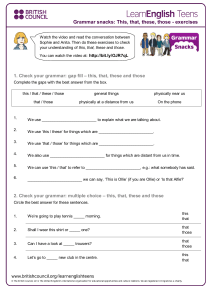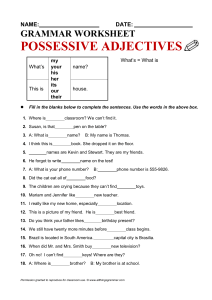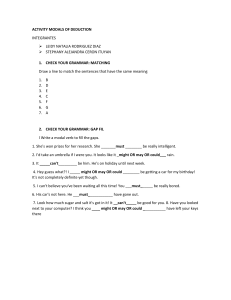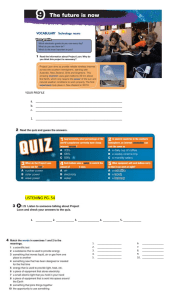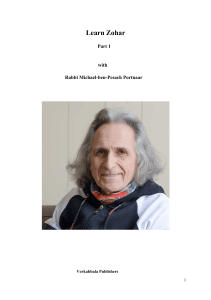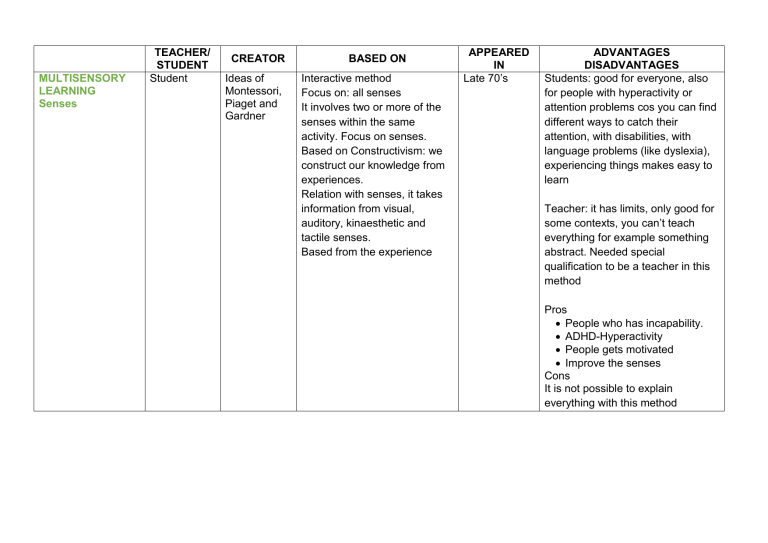
MULTISENSORY LEARNING Senses TEACHER/ STUDENT Student CREATOR Ideas of Montessori, Piaget and Gardner BASED ON Interactive method Focus on: all senses It involves two or more of the senses within the same activity. Focus on senses. Based on Constructivism: we construct our knowledge from experiences. Relation with senses, it takes information from visual, auditory, kinaesthetic and tactile senses. Based from the experience APPEARED IN Late 70’s ADVANTAGES DISADVANTAGES Students: good for everyone, also for people with hyperactivity or attention problems cos you can find different ways to catch their attention, with disabilities, with language problems (like dyslexia), experiencing things makes easy to learn Teacher: it has limits, only good for some contexts, you can’t teach everything for example something abstract. Needed special qualification to be a teacher in this method Pros People who has incapability. ADHD-Hyperactivity People gets motivated Improve the senses Cons It is not possible to explain everything with this method AUDIO LINGUAL METHOD Army Method TEACHER/ STUDENT Teacher CREATOR Skinner’s behaviourism/ conductivism BASED ON It’s a new key Interactive method Like direct method Focus on: Listening Speaking (pronunciation) Visual aids Don´t focus on teaching vocabulary. Vocabulary is taught in context Reinforcement positive and negative: correct behaviour receives positive feedback, while errors receive negative feedback. Audio-visual aids are used+ APPEARED IN 2º W.W But it started as a method late 50’s ADVANTAGES DISADVANTAGES Pros: Students: develop the oral skills and the oral abilities, learn and understand our own rhythm, with lower level, close the way to learn the natural language, students hear, speak, read and then write (LSRPW). Teacher: audio-visual aids is effective in vocabulary teaching. Cons: Students: It requires memorise instead of learning words through of the practice, the pupil is in a passive role, he has little control about his learning. Teacher. It is a teacher dominated method, it could be mechanical with the repetitions. GRAMMAR TRANSLATION METHOD GTM CLASSICAL TRADITIONAL METHOD TEACHER/ STUDENT Student CREATOR From the practice of teaching Latin APPEARED IN Structure teaching is in the 1500´s (16’s mother tongue century) It is Analytical/ Very academic based in two Use reading + Writing dead Translation/ learning by habits languages: Focus on grammar Latin and Not needed a high level of the Greek foreign level BASED ON Structural/analytical method. Focus on: grammar rules and vocabulary Instructions are given in mother tongue Memorize grammar rules by rote and translate to L1 Uses reading writing: students practice the rules by doing translate sentences ADVANTAGES DISADVANTAGES Pros: Students: students develop general mental discipline cos it´s a mechanical method. speaking and listening are overlooked. Teacher: Easy for teaching, the teacher is not required to have a high level of foreign language Cons: Students: speaking and listening are overlooked COMMUNICATIVE APPROACH Communicative language teaching (CLT) TEACHER/ CREATOR STUDENT Students Linguists who were dissatisfied with the audiolingual and grammar translation methods. They felt that students were not learning enough realistic language APPEARED IN Structure teaching is in target 80´s & 90’s language Dynamic- interactive. Use listening + Speaking Communicating in real life contexts. Focus on being fluent Required to have a high level of foreign language BASED ON Interactive method Focus on: Speaking (being fluent) Teaching 100% in target language, everything gives is in foreign language Communicating in real-life context Teacher is required to have a higher level of teaching Uses listening +speaking (most important ability) language is taught by using real-life situations that necessitate communication, and they change from day to day ADVANTAGES DISADVANTAGES Pros: Students: it’s easy for shy students shy to speak because they are speaking about their roles and not about themselves. It’s better for new languages TASK BASED LEARNING (TBL) TEACHER/ STUDENT Student CREATOR Was popularized by N. Prabhu BASED ON ADVANTAGES DISADVANTAGES Activities with a specific objective Pros Real life situations / contexts Students: are motivated to use Student s-centred language creatively and No translation. 100% target language spontaneously through tasks and Work in groups. Cooperation + Collaboration problem solving. Develop fluency Focus on: describe the meaning instead to and student confidence translate Real-life situations/contexts 100% given in target language • cooperation + collaboration • good for Cons harm work Students: Some students need more Task: most important element guidance. They typically translate Process not outcome: learning by doing task and use their L1 rather than the using the target language with own student’s target language in completing the experience. The task reflects real life and learners tasks. focus on meaning, they are free to use any language they want Teacher: requires a high level of Pretask: The instructors may present a model of creativity and initiative the task and learners are responsible for selecting the appropriate language for any given context themselves Task: the students perform the task and teacher is limited to observe or consult Review: learners can review each other's work and offer constructive feedback DIRECT METHOD (Natural method) TEACHER/ STUDENT Student CREATOR Pendergast and Saveur BASED ON APPEARED IN Interactive method Focus on: Speaking pronunciation) Never translate: demonstrate, not explain or translate Basic vocabulary: given through known words, demonstration, objects (realia) No grammar rules Oral transmission: new things are introduced orally Learning by self-correction Language is learned only through demonstration, instead of explaining grammar rules, students use language naturally and spontaneously so that they induce grammar. It was established in Germany and France around 1900 instead of the grammar– translation method ADVANTAGES DISADVANTAGES Pros Students: it makes more attractive for those who have needs of real communication in the target language. It is a natural method which teaches language in the same way the mother tongue is acquired. Cons: Students: Did not take well in public schools because of classroom size: it means that in large classroom is more difficult to pay attention to all students, Teacher background: if we don´t have a native speaker or native like fluency makes difficult to use this method because it’s everything by conversation and not native teacher probably could have some problems with pronunciation TEACHER/ CREATOR BASED ON STUDENT TOTAL Teacher James J. Interactive method PHYICAL Asher Focus on: listening which is RESPONSE linked to physical (TPR) actions/movements which are designed to reinforce comprehension of basic items. Kinaesthetic intelligence, and speaking. Never grammar and writing It’s related with right hemisphere activity, responsible of motormovement learning. Look and repeat: Teachers give commands to students, saying something and demonstrating it with a body action, and students have to response with a whole-body action. APPEARED ADVANTAGES IN DISADVANTAGES 1960’s in Pros USA Students: Increase memory capacity. Helps to acquire vocabulary, tenses aspects, classroom language, imperatives/instructions and storytelling. Beneficial for people with dyslexia or attention deficit hyperactivity disorder. It involves both left-and-rightbrained learning. Cons: Students: It´s almost only practical with beginner levels (grammar is not taught). Does not encourage the development of creative capacity. Does not improves reading, oral and writing skills. At first, it could be embarrassing for those who are not accustomed to this type of methods. Teacher: Needs little preparation time and materials, and it does not actually matter the space and the number of students. It can be repetitive. TEACHER/ STUDENT SUGESTIOPEDIA Teacher is the source of all information, students active in assimilating CREATOR BASED ON Lozanov (Bulgaria) Lonny Gold (expert trainer)Sugestiopedia in practise Focus on: fluency, learning through mistakes, it’s no necessary to correct everything, everything needs to be positive, teacher needs, everything is a selection of the best thing to create the best atmosphere and environment Innovative method promising great effectiveness Keys element: - Music, the use of music to relax learners. (chill out). Relaxation and Positive suggestion is a key element – Classroom environment furniture and decorations have to be comfortable, to create the perfect environment. The approach was based on the power of suggestion in learning, the notion being that positive suggestion would make the learner more receptive and, in turn, stimulate learning. To have relaxed but focused state is the optimum state for learning Structure lessons: Prelude (teacher gives students explanations) first concert reading (Focus on reading exaggerated with music), decoding (images jokes that involves a surprise and natural fact which involves both hemispheres brain to make you recording), activation (to reinforce the knowledge and make u remember) (repetitions to improve pronunciation and become more creative with language, Bll games, card names, board names), relation concert. (play classical barroc music from 17 century) *** New personalities: teacher gives students new personalities to motivate, when learners are not comfortable to speak so it’s easy for them to have a new personality APPEARED IN 70’s it becomes famous Origen of the name it’s a combination of two words: suggestion + pedagogy ADVANTAGES DISADVANTAGES Pros: It makes a comfortable and relaxing environment, and a relationship between the teacher and the student that is akin to the parent-child relationship. We can also benefit from the use of music to get students sit back and relax. Cons: Teachers: It is not a practical method as teachers face the problem of the availability of music and comfortable chairs. It’s not possible all time, because of big groups. CREATOR GRAMMAR Caleb Gattegno TRANSLATION METHOD BASED ON Focus on the idea that teachers should be as silent as possible during a class but learners should be encouraged to speak as much as possible. The learner needs to discover or create Learning is made easier using physical objects such as Cuisenaire rods Learning is made easier by problem solving using the target language Focus on: pronunciation, imitation. Not translation, repetitions. Language is taught through sentences in a sequence based on grammatical complexity. Use of: Cuisenaire roods: there is a soundcolor chart which is used to teach the language sounds, coloured word charts which are used for work on sentences, and coloured charts which are used to teach spelling. APPEARED IN Early’s 1970 ADVANTAGES DISADVANTAGES Pros: Students: The method emphasizes learner autonomy and active student participation. Teachers: should concentrate on how students learn, not on how to teach
